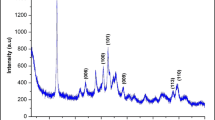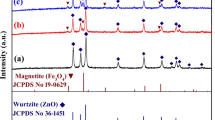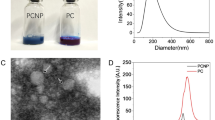Abstract
Exposure to ultraviolet (UV) radiation has been known to cause skin cancer, erythema, and sunburn. Continuous efforts have been made to make sunscreens more efficient and non-toxic. Inorganic sunscreens like TiO2 and ZnO are continued to be used for a few decades, and they are efficient in giving protection against harmful UV radiation, but they are photochemically active as well. They generate free radicals upon irradiation, which leads to reactive oxygen species (ROS) generation which is harmful to the human skin. Hydroxyapatite (HA) is a biocompatible material as it has a composition the same as the mineral content of the human bone; therefore, it is suitable for the dermatological application. Though HA itself does not provide protection against UV, studies on doped HA with various ions showed excellent performance. Pure HA absorbs only between 200 and 340 nm, with an intense band below 247 nm. HA doped with bivalent Zn2+, Fe2+, and trivalent Fe3+ and Cr3+, showed absorbance in the entire UV region. TiO2 provides absorbance in the entire UV range, while ZnO does so only in UVA. Compared to HA (refractive index, n = 1.6), TiO2 (n = 2.6) and ZnO (n = 1.9) have higher refractive index, which gives unwanted whitening effect. Additional properties can be brought in HA composites by adding material while retaining their individual properties. As HA is not photocatalytic, it does not lead to a generation of free radicals. This paper throws light on several aspects of HA-based sunscreen filters as an emerging future cosmetic material, and brief analysis and conclusions.



Similar content being viewed by others
References
Rai, R., Shanmuga, S.C., Srinivas, C.: Update on photoprotection. Indian J Dermatol. 57, 335–342 (2012)
Amin, R.M., Elfeky, S.A., Verwanger, T., Krammer, B.: A new biocompatible nanocomposite as a promising constituent of sunscreens. Mater. Sci. Eng. C. 63, 46–51 (2016)
Rünger, T.: Role of UVA in the pathogenesis of melanoma and non-melanoma skin cancer: a short review. Photodermatol Photoimmunol Photomed. 15, 212–216 (1999)
Gardiner, J., Bailey, P., Makino, T., Heerink, B.: Colipa guidelines: international sun protection factor (SPF) test method. Eur Cosmet Assoc. 1, 1–9 (2006)
De Araujo, T., De Souza, S., Miyakawa, W., De Sousa, E.: Phosphates nanoparticles doped with zinc and manganese for sunscreens. Mater Chem Phys. 124, 1071–1076 (2010)
Manaia, E.B., Kaminski, R.C.K., Corrêa, M.A., Chiavacci, L.A.: Inorganic UV filters. Braz J Pharm Sci. 49, 201–209 (2013)
Jain, S., Jain, N.: Multiparticulate carriers for sun-screening agents. Int J Cosmet Sci. 32, 89–98 (2010)
Narayanan, D.L., Saladi, R.N., Fox, J.L.: Ultraviolet radiation and skin cancer. Int J Dermatol. 49, 978–986 (2010)
Rebecca, L., Siegel, K., Miller, D., Ahmedin, J.: Cancer statistic. CA Cancer J Clin. 68, 7–30 (2018)
Moyal, D.D., Fourtanier, A.M.: Broad-spectrum sunscreens provide better protection from solar ultraviolet–simulated radiation and natural sunlight–induced immunosuppression in human beings. J Am Acad Dermatol. 58, S149–S154 (2008)
Séïté, J.-F., Cornec, D., Renaudineau, Y., Youinou, P., Mageed, R.A., Hillion, S.: IVIg modulates BCR signaling through CD22 and promotes apoptosis in mature human B lymphocytes. Blood. 116(10), 1698–1704 (2010)
Madan, V., Lear, J.T., Szeimies, R.-M.: Non-melanoma skin cancer. Lancet. 375, 673–685 (2010)
Jansen, R., Osterwalder, U., Wang, S.Q., Burnett, M., Lim, H.W.: Photoprotection: part II. Sunscreen: development, efficacy, and controversies. J Am Acad Dermatol. 69, 861–867 (2013)
De Araujo, T., De Souza, S., De Sousa, E.: Effect of Zn2+, Fe3+ and Cr3+ addition to hydroxyapatite for its application as an active constituent of sunscreens. J Phys Conf Ser. 249, 1–7 (2010)
Piccirillo, C., Rocha, C., Tobaldi, D., Pullar, R., Labrincha, J., Ferreira, M., Castro, P.M., Pintado, M.: A hydroxyapatite–Fe2O3 based material of natural origin as an active sunscreen filter. J Mater Chem B. 2, 5999–6009 (2014)
Morsy, R., Ali, S.S., El-Shetehy, M.: Development of hydroxyapatite-chitosan gel sunscreen combating clinical multidrug-resistant bacteria. J Mol Struct. 1143, 251–258 (2017)
Pyo, E., Kim, Y., Park, J.B., Kwon, K.Y.: A silver-doped hydroxyapatite for an active sunscreen material. Bull Kor Chem Soc. 37, 1395–1396 (2016)
Teixeira, M., Piccirillo, C., Tobaldi, D., Pullar, R., Labrincha, J., Ferreira, M., Castro, P.M., Pintado, M.: Effect of preparation and processing conditions on UV absorbing properties of hydroxyapatite-Fe2O3 sunscreen. Mater Sci Eng C. 71, 141–149 (2017)
Pelizzo M., Zattra E., Nicolosi P., Peserico A., Garoli D., Alaibac M.: In vitro evaluation of sunscreens: an update for the clinicians. International Scholarly Research Network, ISRN Dermatol, 1–4 (2012). https://doi.org/10.5402/2012/352135
Antoniou, C., Kosmadaki, M.G., Stratigos, A.J., Katsambas, A.D.: Sunscreens–what’s important to know. J Eur Acad Dermatol Venereol. 22, 1110–1119 (2008)
Wang, S.Q., Balagula, Y., Osterwalder, U.: Photoprotection: a review of the current and future technologies. Dermatol Ther. 23, 31–47 (2010)
Serpone, N., Dondi, D., Albini, A.: Inorganic and organic UV filters: their role and efficacy in sunscreens and suncare products. Inorganica Chim Acta. 360, 794–802 (2007)
Popov, A.P., Priezzhev, A.V., Lademann, J., Myllylä, R.: Monte Carlo calculations of UV protective properties of emulsions containing TiO2, Si and SiO2 nanoparticles. In: Advanced Laser Technologies 2007, International Society for Optics and Photonics, vol. 7022, pp. 702211–702217 (2008)
Smijs, T.G., Pavel, S.: Titanium dioxide and zinc oxide nanoparticles in sunscreens: focus on their safety and effectiveness. Nanotechnol Sci Appl. 4, 95 (2011)
Monteiro-Riviere, N.A., Wiench, K., Landsiedel, R., Schulte, S., Inman, A.O., Riviere, J.E.: Safety evaluation of sunscreen formulations containing titanium dioxide and zinc oxide nanoparticles in UVB sunburned skin: an in vitro and in vivo study. Toxicol Sci. 123, 264–280 (2011)
Nohynek, G., Dufour, E., Roberts, M.S.: Nanotechnology, cosmetics and the skin: is there a health risk? Skin Pharmacol Physiol. 21, 136–149 (2008)
Newman, M.D., Stotland, M., Ellis, J.I.: The safety of nanosized particles in titanium dioxide–and zinc oxide–based sunscreens. J Am Acad Dermatol. 61, 685–692 (2009)
Gilbert, E., Pirot, F., Bertholle, V., Roussel, L., Falson, F., Padois, K.: Commonly used UV filter toxicity on biological functions: review of last decade studies. Int J Cosmet Sci. 35, 208–219 (2013)
Osmond, M.J., Mccall, M.J.: Zinc oxide nanoparticles in modern sunscreens: an analysis of potential exposure and hazard. Nanotoxicology. 4, 15–41 (2010)
Tucci, P., Porta, G., Agostini, M., Dinsdale, D., Iavicoli, I., Cain, K., Finazzi-Agro, A., Melino, G., Willis, A.: Metabolic effects of TiO2 nanoparticles, a common component of sunscreens and cosmetics, on human keratinocytes. Cell Death Dis. 4(3), 1–11 (2013)
Sayre, R.M., Dowdy, J.C., Gerwig, A.J., Shlelds, W.J., Lioyd, R.V.: Unexpected photolysis of the sunscreen octinoxate in the presence of the sunscreen avobenzone. Photochem Photobiol. 81, 452–456 (2005)
Sánchez-Quiles, D., Tovar-Sánchez, A.: Sunscreens as a source of hydrogen peroxide production in coastal waters. Environ Sci Technol. 48, 9037–9042 (2014)
Virkutyte, J., Al-Abed, S.R.: Statistical evaluation of potential damage to the Al(OH)3 layer on nTiO2 particles in the presence of swimming pool and seawater. J Nanopart Res. 14, 787 (2012)
Lewicka, Z.A., Benedetto, A.F., Benoit, D.N., William, W.Y., Fortner, J.D., Colvin, V.L.: The structure, composition, and dimensions of TiO2 and ZnO nanomaterials in commercial sunscreens. J Nanopart Res. 13, 3607 (2011)
Webster, T.J., Massa-Schlueter, E.A., Smith, J.L., Slamovich, E.B.: Osteoblast response to hydroxyapatite doped with divalent and trivalent cations. Biomaterials. 25, 2111–2121 (2004)
Harry, R.G.: Harry’s Cosmeticology, 6th edn. Leonard Hill Books an Intertext Publisher, London (1973)
Miyaji, F., Kono, Y., Suyama, Y.: Formation and structure of zinc-substituted calcium hydroxyapatite. Bull Mater Sci. 40, 209–220 (2005)
Villalobos-Hernandez, J., Müller-Goymann, C.: Sun protection enhancement of titanium dioxide crystals by the use of carnauba wax nanoparticles: the synergistic interaction between organic and inorganic sunscreens at nanoscale. Int J Pharm. 322, 161–170 (2006)
Pardo, J., Peña, J., Merino, R., Cases, R., Larrea, A., Orera, V.: Spectroscopic properties of Er3+ and Nd3+ doped glasses with the 0.8 CaSiO3–0.2 Ca3(PO4)2 eutectic composition. J Non-Cryst Solids. 298, 23–31 (2002)
Rhazi, M., Desbrieres, J., Tolaimate, A., Alagui, A., Vottero, P.: Investigation of different natural sources of chitin: influence of the source and deacetylation process on the physicochemical characteristics of chitosan. Polym Int. 49, 337–344 (2000)
No, H.K., Kim, S.H., Lee, S.H., Park, N.Y., Prinyawiwatkul, W.: Stability and antibacterial activity of chitosan solutions affected by storage temperature and time. Carbohydr Polym. 65, 174–178 (2006)
Acknowledgments
Authors would like to thank the Science and Engineering Research Board (SERB), Department of Science and Technology (ECR/2015/000339).
Author information
Authors and Affiliations
Corresponding author
Additional information
Publisher’s note
Springer Nature remains neutral with regard to jurisdictional claims in published maps and institutional affiliations.
Rights and permissions
About this article
Cite this article
Pal, A., Hadagalli, K., Bhat, P. et al. Hydroxyapatite—a promising sunscreen filter. J Aust Ceram Soc 56, 345–351 (2020). https://doi.org/10.1007/s41779-019-00354-2
Received:
Revised:
Accepted:
Published:
Issue Date:
DOI: https://doi.org/10.1007/s41779-019-00354-2




